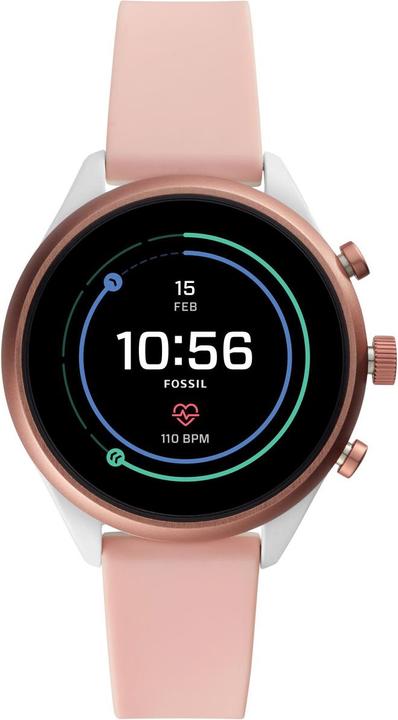

Fossil Sport: Finally a decent Android watch?
There are many Android watches. But none are really any good. The Fossil Sport is supposed to be the long-awaited saviour. Spoiler: It's not, but it's going in the right direction.
Wear OS does not have the best reputation. Major software updates are rare and hardware development has almost completely stagnated. Nevertheless, the response to the Fossil Sport from many testers was extremely positive. The smartwatch is equipped with the successor to the five-year-old Qualcomm Snapdragon 2100 processor, but even with the new 3100 chip, the smartwatch does not make any leaps and bounds. Nevertheless, it gives cause for hope.
An eye-catcher
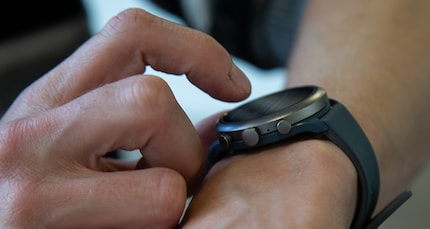
The Fossil Sport is available in two sizes: 43 and 41 millimetres. The displays are practically identical (1.29 inch and 1.19 inch OLED) and have the same resolution (390 x 390 pixels). Both models have interchangeable straps with a width of 18 mm and 22 mm respectively. I had the larger model at my disposal for the test. Fossil offers numerous colour options. However, we currently only stock three variations.
Optically, I really like the simple design. Especially because the Fossil Sport has a flat surface compared to my Huawei Watch 2. This makes it much easier to operate the touch display than with a protruding edge. The three buttons and the rotating crown also provide an elegant touch. To top it all off, the Fossil Sport is just 12 mm thick and an absolute lightweight. This may be a negative for some, but I appreciate the lightness enormously.
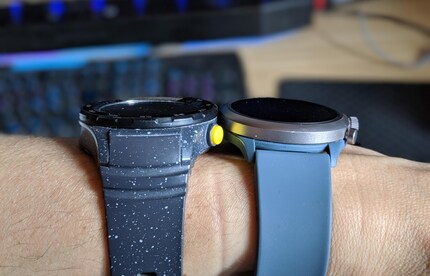
The flat design shows off the display to its best advantage. The Fossil Sport is a real eye-catcher. But smartwatches aren't just for looking at, and that's where the problems start.
"New" hardware, old problems
The Snapdragon 3100 is based on the same architecture as the 2100 chip. The processor with four ARM Cortex
A7 is exactly the same. The same goes for the Adreno 304 graphics accelerator, which is not the hoped-for leap in performance that Wear OS watches desperately need. Instead, the Snapdragon 3100 focuses primarily on battery improvements and even I didn't feel much of that. The Fossil Sport still has to be connected to the small wireless dock every evening. With the always-on display, I usually have around 20 per cent battery left when I go to bed.
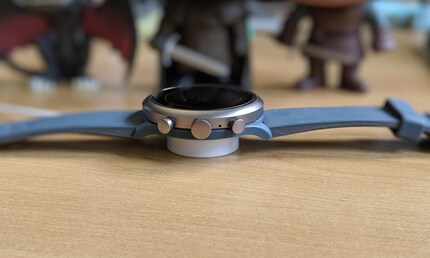
I can live with that. What I can't live with is the poor performance. The Fossil Sport feels slow - right out of the box. Rarely does anything work really smoothly. Every now and then an input is not registered. Or an app starts so slowly that I have to click several times. The watch simply stopped three times. I only realised after two hours that the time was no longer correct. The fact that it took so long also shows how often I use the device. I was able to restart the watch with a hard reboot (long press on the crown).
The Fossil Sport runs a lot better than my Huawei Watch 2, but only because the latter became almost unusable after less than a year due to performance and battery problems. I can't yet judge how the Fossil Sport will perform in a few months. I've been using it for over three weeks now.
Practical approaches with Tiles and Google Pay
The user experience is not all bad. Wear OS is relatively quick and easy to navigate despite some lags. You can swipe the display in four directions. From left to right it shows the Google Assistant, from top to bottom opens the Quick Settings, from bottom to top current notifications and from right to left Google Fit. The watch also has three buttons. The centre one can be rotated. The top and bottom buttons can be customised with shortcuts. In my case, they start Strava and Google Pay. The crown takes you to the app overview, which you can scroll through using the wheel. However, you cannot open the apps with another click. Otherwise you will end up back on the home screen. The fact that you can only tap the app is somewhat misleading.
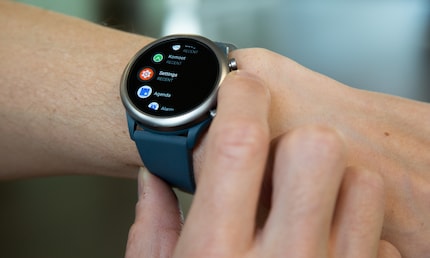
The Watch Faces from Fossil focus primarily on fitness in conjunction with Google Fit. Although there are thousands of watch faces in the Play Store, very few of them appeal to me. I am more than satisfied with the three pre-installed ones from Fossil (plus 17 more via the Wear OS app). You can change the colour and the information displayed if you wish.
Google recently delivered a new update with Tiles. Swiping from right to left still opens Google Fit. However, you can now swipe further and navigate to various tiles such as weather, news, appointments, etc. However, my Fossil Sport has not yet received the update.
I have high hopes for mobile payments. As Google Pay is now also available in Switzerland and it is the only payment method that the watch allows, I tried it out straight away. It should work wherever contactless payment is possible. Unfortunately, Google Pay is not much more practical than a bank card. Firstly, you have to turn the watch to the terminal in order to establish the connection via NFC. But before that, you first have to start Google Pay on the watch. By default, this is done via the Quick Menu. To speed up this step, I have placed Google Pay on one of the buttons.
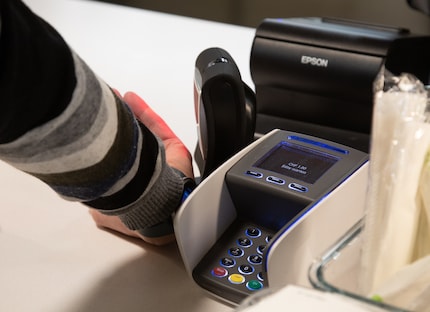
Even with this, the situation usually plays out like this: I stand in front of the card terminal in the nearby café and twist my arm. The shop assistant rolls her eyes, while the annoyed cappuccino mob behind me pulls out torches and pitchforks. Meanwhile, my watch shows me that my heart rate has risen to 120. A relaxed payment experience looks different. I'm usually quicker when I pull out my wallet and fish out a card anyway.
No matter what I need the watch for, I'm faster for almost all applications when I go straight to my smartphone. I also always need both hands for the watch. I usually control the music directly on my headphones and I have to reply to messages on my mobile anyway if I need more than "OK" or a smiley. Nevertheless, I like to swipe through the various notifications or use Google Fit to see how much exercise I've done. If only because the apps look so smart on the Fossil display.
But not so sporty
In addition to the notifications, I primarily use the watch for sport. However, the battery is only just sufficient for longer bike tours. At least when I have GPS switched on - without it, there's not much point. After four hours, it's usually over.
Once again, I tried out the Komoot app for navigating bike trails. It shows you every descent, no matter how small. It would be extremely practical not to have to constantly pull out your mobile to find the way and use your smartwatch instead. Unfortunately, the app is still far too unreliable and regularly shows turn-offs too late or is too inaccurate.
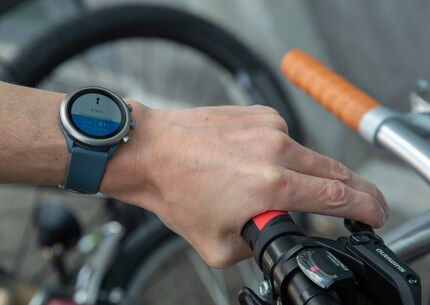
For shorter trips or jogging, however, the Fossil Sport is perfectly adequate. The GPS signal is found quickly and the optical heart rate monitor can also be used with a dedicated sports watch such as the Polar Vantage V.
Conclusion: Quite nice
If someone were to ask me what I thought of the Fossil Sport, my answer would be: "Easy". It doesn't do anything particularly well, but it doesn't do anything particularly badly either. Looks and wearing comfort are great. It is a useful sports watch. The heart rate monitor is reliable, GPS is available, but the battery doesn't last very long. Wear OS is now a very useful operating system that is pleasant to use. However, there is still a lack of clever Wear OS apps. My main criticism, however, concerns the performance. The watch is simply too slow. Every input takes far too long and it doesn't feel fluid enough to use. Incidentally, you can't make calls with it either. Sorry K.I.T.T.
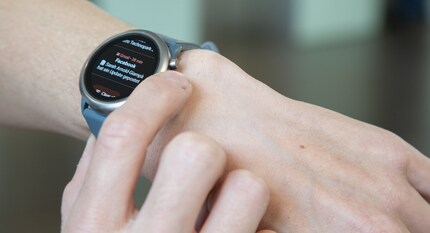
Because the Fossil Sport is relatively inexpensive, I can still recommend it. If you're really looking for a smartwatch and can put up with a few hiccups here and there, go for it. I would keep it, but probably not buy it. I'm still hoping that Google will finally unveil the Pixel Watch. And with its own chip. Without it, Wear OS won't be able to break out of its insignificance.
As a child, I wasn't allowed to have any consoles. It was only with the arrival of the family's 486 PC that the magical world of gaming opened up to me. Today, I'm overcompensating accordingly. Only a lack of time and money prevents me from trying out every game there is and decorating my shelf with rare retro consoles.


